Table of Contents
Want to minimise your luggage setup by putting together an ultralight bikepacking kit? You’ve come to the right place.
Lots of people in the ultra-distance bike racing world have shown how minimal you can go if you have the impetus. It still impresses me that some riders complete three-week races with less than 10 litres of total volume (eg. half frame bag + xs saddle bag). While being this minimal gives us a glimpse of what’s possible, this article will add a level of comfort and practicality to ensure the advice is as realistic as possible for self-supported bike adventures.
Right, let’s get stuck into it!
General Advice For Creating An Ultralight Bikepacking Kit

Take only what you need.
It’s obvious, but it’s time to be realistic about the necessity of each item. I learned how to pack less gear by restricting my bag volume. With just 30-litres, you’ll be forced to think super hard about every single item you want to take.
Multi-use items.
Clothes are the prime example. Wear your rain jacket as a warmth layer when it’s cold. Ride in t-shirts and shirts instead of cycling-specific jerseys. Wear running shoes that you can ride and hike in, or clip-in shoes for everything if you’re not the walking type. Another multi-use item is a smartphone because they’re capable of meeting your navigation, communication, photography and research needs.
Food and water are heavy.
You only need to take the food and water you’ll use between each re-stocking point. Eat big in towns and snack in between. Dehydrated foods are obviously a real winner for backcountry stuff. Think pasta, rice, oats, lentils, mushrooms and dried fruit. High-calorie foods go a long way too, I tend to always have a stash of nuts and seeds.
Start reducing the weight of heavy things first as they often have the most weight to lose:
1. Bike (7-12kg)
2. Tent (sub-1500g)
3. Sleeping Bag (sub-1000g)
4. Sleeping Mat (sub-500g)
5. Cooking equipment (sub-500g)
6. Lightweight clothing and accessories (sub-200g, but the total suite can add up)
Bikepacking and Light Touring Bikes
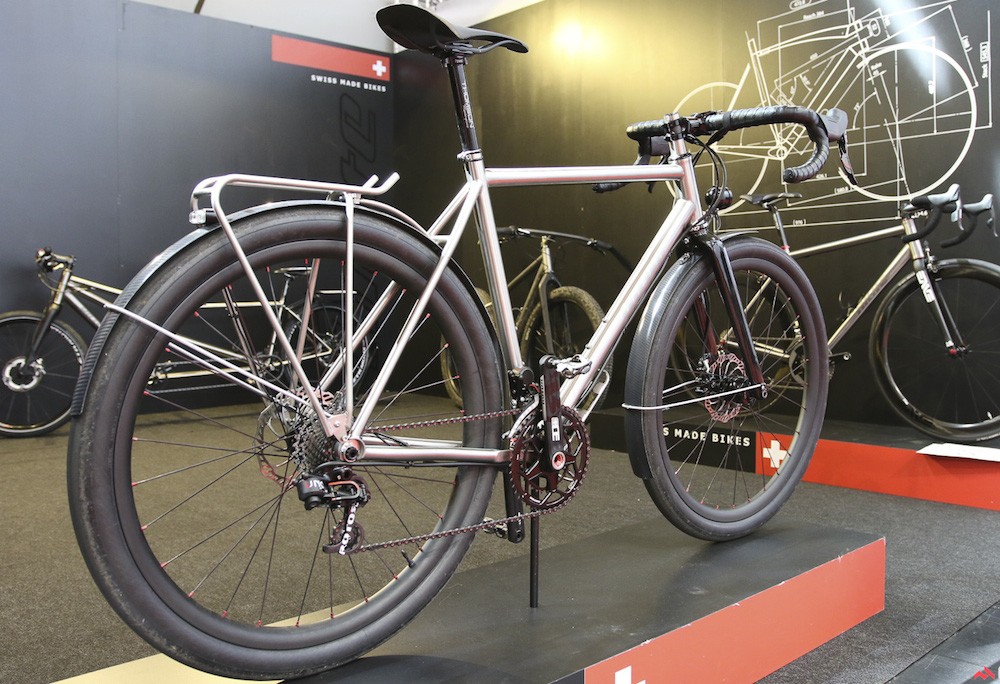
If you’re packing light, your bike is a great place to drop lots of weight. Some individual components offer big savings if you’re savvy enough.
Folding Tyres
The most effective location to reduce weight is your tyres. Tyres come in two varieties: one uses a wire bead to give the tyre its shape, and the other a folding kevlar bead. Many bikes come stock with wire bead tyres which are heavier and use low-grade rubber compounds. Folding tyres work out more expensive, but the dollars-per-gram saved is often excellent. Keep in mind that a heavier tyre may actually have a lower rolling resistance, resulting in faster cycling speeds!
Lightweight Tubes or a Tubeless Setup For 2.0”+ Widths
Tubes can be heavy. A thin, lightweight tube is often only a little bit more expensive than a regular tube but it can be less than half the weight. If you’re running wide tyres, tubeless setups tend to offer the lightest solution and the sealant does a great job of sealing small holes. For spares, the Tubolito tubes are almost certainly the lightest (and most expensive) out there.
Wheels
If you upgrade the wheels on your stock bike, you can likely drop 500+ grams. It’s not necessary to use expensive carbon wheels either; you’ll find sub-1500 gram road wheelsets and sub-1600 gram off-road wheelsets built using aluminium rims. The main benefit of a carbon rim is the increased wheel stiffness they offer.
Mountain Bike Fork
If your bike has suspension, do you really need it? A carbon rigid fork can weigh between 500-600 grams which will be a huge saving from the usual suspension fork weight of 1500-2500g. Aluminium rigid forks are a more cost-effective option, typically weighing between 600-1000g.
Seatpost
Many stock bikes come with very heavy aluminium posts. I recommend fitting a carbon seatpost to save 100-200 grams, but more importantly, to achieve a smoother ride due to the additional flex built-in.
Rack
If your bike came with a rack, the chances are it’s heavy. You can get away with lighter racks with reduced payloads when you’re packing minimally.
For US $1000 you can expect:
– Your road bike setup to be under 10kg
– Your cyclocross bike setup to be under 11kg
– Your mountain bike setup to be under 12kg
For your ultralight kit, aim to have everything under 20kg, including the bike.
Luggage

If you’re currently using four standard panniers, you can get some pretty decent weight savings with a change of luggage. By switching to bikepacking bags you’ll get the aerodynamic advantage too.
Panniers
Arkel DryLite 30 Litre Panniers – 540 grams
Tubus Airy Titanium Rack – 233 grams
Tubus Vega Evo Steel Rack – 440 grams
Bikepacking Bags
Wild Cat Handlebar Harness + Drybag 13 Litres – 214 grams
Lone Peak Handlebar Hauler + Drybag 13 Litres – 325 grams
Ortlieb Handlebar Pack 15 Litres – 430 grams
Ortlieb Seat Pack 16.5 Litres – 417 grams
I’ve written in detail about the bikepacking bag vs pannier weight difference HERE.
Shelters
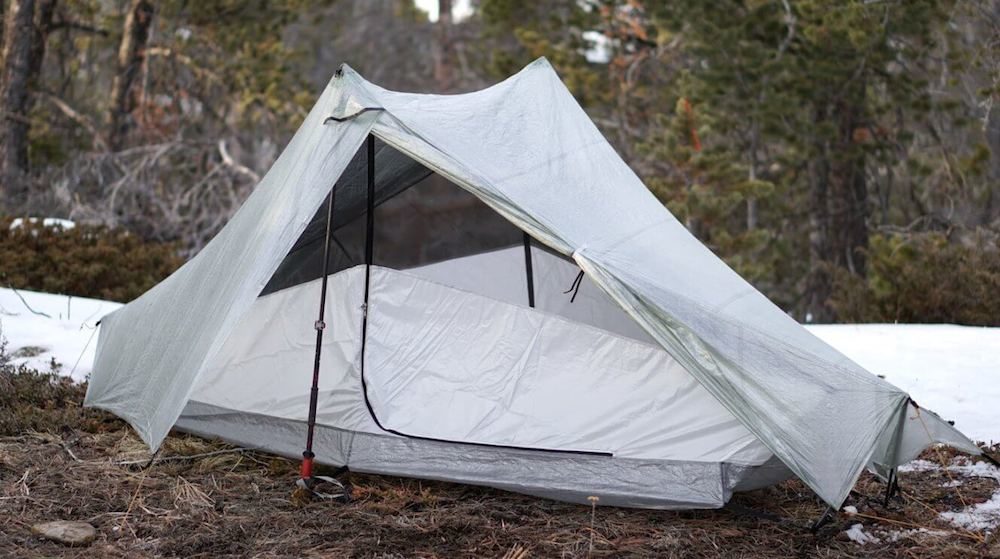
Shelters are an ok way to shed some weight, but they can sometimes have a significant effect on your comfort without dropping the grams to match. Double-wall tents offer excellent comfort and are available sub-1000 grams. The tent inner keeps the insects out (especially mosquitos and sand flies) and the fly is a delight to have on those rainy days too.
Pyramid tarps are the lightest 4-season capable shelters. These are often modular allowing you to choose whether you want to pair it with a groundsheet or mesh inner. The tarp itself is around 500 grams, and it’s another 500 grams for a pole, groundsheet and stakes.
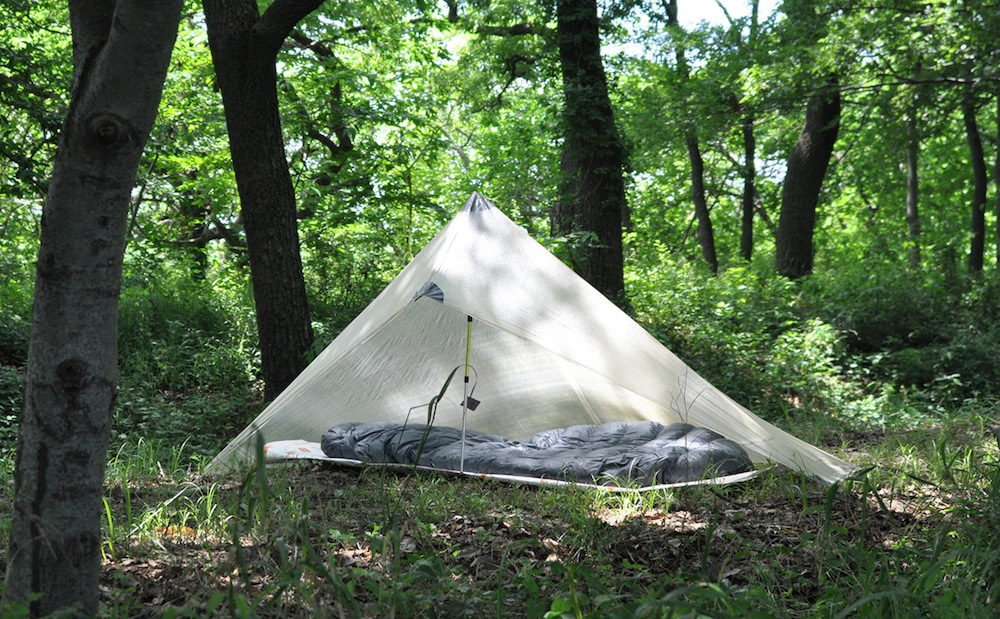
The classic ultralight option is a bivy and/or tarp setup. A bivy is just a waterproof sleeping bag cover which is best suited to cooler climates. You can find emergency bivys are as light as 120 grams, but the weatherproof and featured bivys will typically weigh between 350-600 grams. Tarps with a carbon pole (70 grams) will afford you a bit more comfort, and you can pitch them anywhere too. By pairing a tarp with a tub groundsheet you’ll find it’s an excellent warm weather shelter under 300 grams.
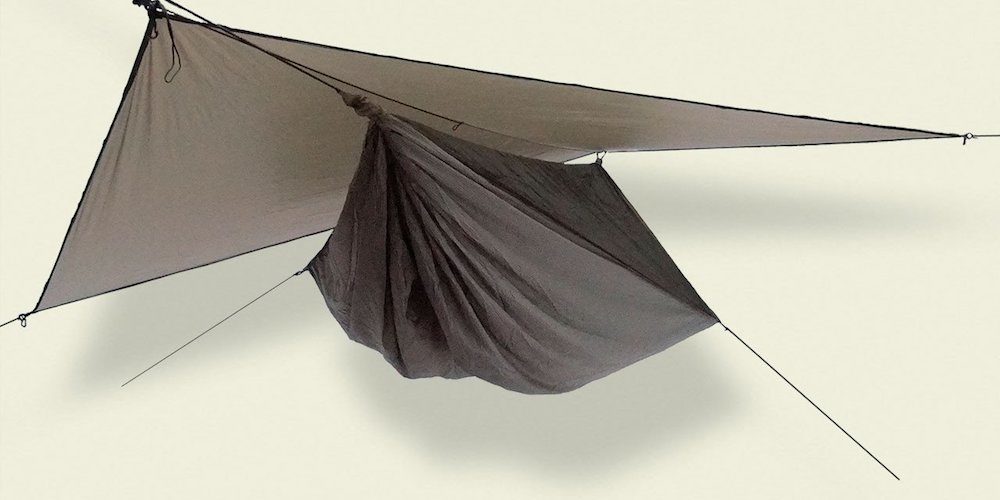
Hammock and tarp setups are similar in weight to the UL double wall tents. Given you don’t need a sleeping mat, hammocks can work out to be very light. Side benefits to a hammock including being better suited to warm conditions and the fact they double as a chair. In sub-zero temperatures make sure you insulate your hammock from below!
Products we like:
Hyperlite UltaMid 4-Season with pole, groundsheet and stakes – 1060 grams
Tarptent Bowfin 1 tent – 1060 grams
Big Agnes Fly Creek HV1 Platinum tent– 822 grams
Hyperlite Echo II with an inner net – 815 grams
Zpacks Solplex with freestanding tent poles – 796 grams
Tarptent Notch-Li with support poles – 779g
Mountain Laurel Designs SoloMid Tent with carbon pole and stakes – 515 grams
Sierra Designs Backcountry Bivy – 386 grams
Mountain Laurel Designs Event Soul Bivy – 340 grams
MontBell Breeze Dry-tec Bivy – 180 grams
Zpacks Hexamid Pocket Tarp with carbon pole – 179 grams
Zpacks Hexamid Pocket Tarp groundsheet with attachments – 102 grams
Hennessy Hyperlite Zip Hammock with rain fly – 793 grams
Sleeping
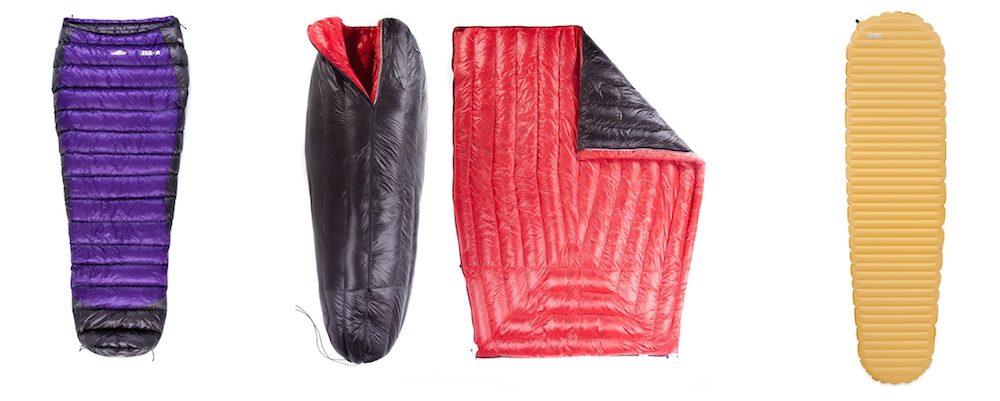
Sleeping Mats
For a great night’s sleep, I’ve found that a high-quality sleeping mat is key. Modern blow-up mats tick all of the boxes: they’re comfortable, compact and well-insulated from the cold ground. But that doesn’t stop ultra racers sleeping on even lighter pieces of closed-cell foam. For cold conditions, you’ll want a mat with a good warmth-to-weight ratio. Sleeping mat ‘warmth’ (or resistance to heat loss) is measured using an R-value. A pad with an R-value of 5.0 is five times warmer than a pad with an R-value of 1.0. Warmer mats allow you to use sleeping bags with less fill because the ground is such a large source of heat loss.
Products we like:
Thermarest Neoair Xlite (R3.1) – 340 grams
Thermarest Neoair Xtherm (R5.7) – 430 grams
Sleeping Bags and Quilts
Sleeping bags and quilts are an excellent place to shed some weight. I say this because the majority of people I meet use bags rated far lower than the conditions they endure, which makes sense; you can use the same bag for all conditions. But for a weight-optimised setup, you’ll want to use a bag with a ‘limit rating’ a few degrees above your expected overnight lows.
Sleeping quilts typically offer the best weight-to-performance because you sleep directly on the mat. Logically, they make a lot of sense as well because the bottom of a sleeping bag is compressed when you lay on it, offering little extra warmth. But keep in mind quilts are prone to cold drafts if you move around a lot in your sleep. Sleeping directly on the inflatable mat can feel a bit yuck too.
If like me, you find the down feather industry absolutely deplorable, I’d recommend picking a synthetic fill option. While syn bags are heavier for the equivalent warmth, they do have the benefit of being more effective when moist. Plus you aren’t paying people to make the life of ducks and geese utterly miserable. 👍
Products we like:
Mont Zero Superlight Down Bag (2C) – 427 grams
Mountain Hardwear UltraLamina Spark Synthetic Bag (1C) – 830 grams
Enlightened Equipment Enigma Down Quilt (-1C) – 421 grams
Enlightened Equipment Enigma Apex Synthetic Quilt (-1C) – 639 grams
Headlamps
While you can use your phone or a bike light as a torch, I haven’t found anything that rivals the practicality of a head torch. Some headlamps are 3-4x heavier than others, so this can be another good place to drop 50-100 grams.
Products we like:
Petzl e+LITE – 26 grams
Cooking Gear
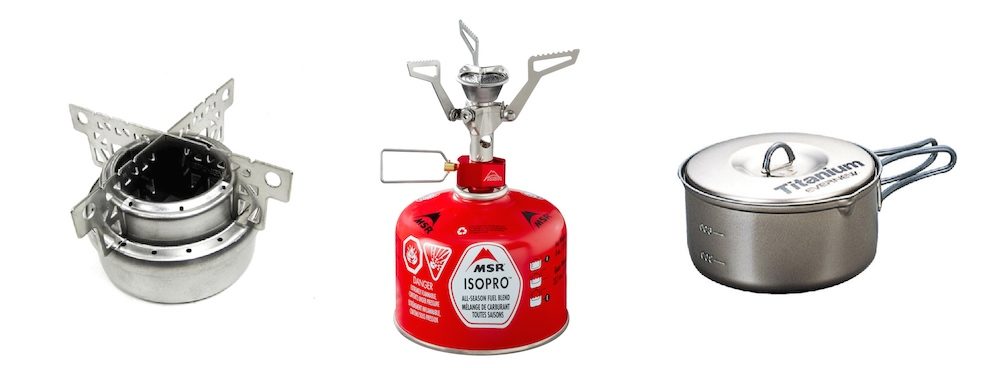
While many UL folks don’t take any cooking equipment, for you this might be a deal breaker. The best way to keep everything light is to use a single pot and make it your bowl/plate/cup too. Don’t want to carry a stove and are handy with an open fire? That might be the lightest stove/fuel you’ll find.
Stoves
Alcohol stoves are undoubtedly the lightest and most compact solution for short-term UL cooking. With about 15 grams of alcohol, you can boil 500ml in about 9-minutes. In comparison, a canister stove will use about 7 grams of fuel (at a rate 4x quicker). While the canister system is heavier without fuel, it offers a better fuel weight per litre of water boiled. The canister system is, therefore, lighter overall after boiling ~8 litres of water. Based on weight alone, this means that on trips longer than 4-8 days and you’ll probably be better off with canisters.
Products we like:
Evernew Titanium Alcohol Stove + Stand + Empty Bottle – 57 grams
MSR Pocket Rocket 2 Canister Stove + Empty Canister – 188 grams
Clickstand T-2 Titanium Stand for Alcohol Stoves – 77 grams
Pots, Cups and Utensils
Here’s a great place to apply the ‘multi-use’ principle; use a single pot to act as your plate, bowl and even cup. Some UL folk use plastic cutlery, but aluminium and titanium gear is not significantly heavier and offers long-term practicality. If you like cutting fruit and vegetables, you’ll want a decent paring knife. I’ve found the Victorinox knives to be the best.
Products we like:
Evernew 1300ml Titanium Pot – 162 grams
Evernew 900ml Titanium Pot – 99 grams
KeepCup 340ml Plastic Cup – 47 grams
Victorinox 8cm Paring Knife – 25 grams
Snow Peak Titanium Spork – 16 grams
The Smaller Things
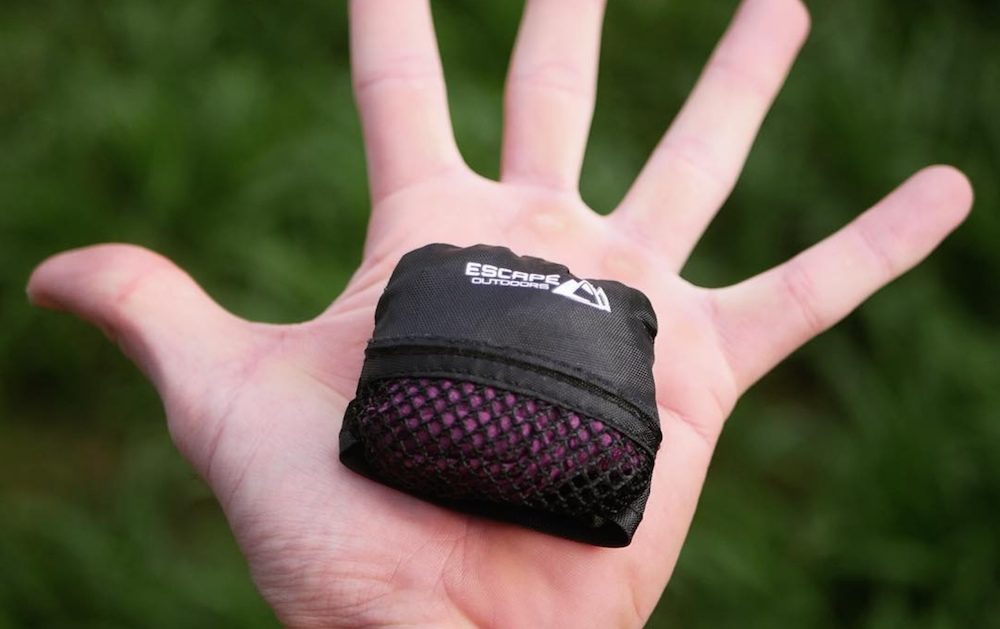
Toiletries
– Soap is soap. Use a small bottle of liquid soap to wash your body, hair, clothes and dishes! You can get environmentally-friendly liquid soaps from most outdoor stores.
– Tiny travel towels work to a great effect after a minute of drip-drying. Don’t expect to dry your hair with them though.
Electronics
– You can do everything with a smartphone these days. It’s your camera, navigation device, research station and mode of communication.
– The Nitecore F1 charger (32 grams) with 18650 rechargeable batteries (48 gram for 3400mAh) is the ultralight USB charging option of choice. You can then bring only the batteries that you need. If you need more than 10000mAh of stored power, it will pay off to use a powerbank.
– The Anker Powercore 13000mAh offers a very large capacity at only 240 grams (54mAh per gram).
– A Kindle eReader (200 grams) is essential for those who like finishing the day with a book. The battery life is incredible too.
Casual Clothing Advice
– Again, it’s all about taking only what you need for the expected weather conditions.
– Combine your casual and riding clothes; there’s no need for both in many cases.
– It’s easy to wash a single set of clothes regularly. Wear them into the shower after a day of riding and give them a clean. In warm climates, your body heat can be used to effectively dry clothes.
– Use a single pair of shoes for everything. If you like being clipped-in and are not planning on hiking all the time, your cycling shoes will be perfect. I’ve done many 20km hikes in my SPD sandals without issue (check out the Japan video for more). Quite a few people also travel with ‘Crocs’. Crocs are under 400 grams, they’re really comfortable and they can dry almost instantly.
Riding Gear
– The rain jacket is one of the best places to shed weight. Lightweight jackets like the Patagonia Storm Racer Jacket (170 grams) can be less than a third of the weight of a standard waterproof jacket.
– When combining waterproof rain pants with leg warmers, you can have a very light and warm setup for sub-zero.
– I use ‘undershorts’ which are mesh padded shorts that fit under my lightweight swimming shorts.
Putting Weight Into Context

I need to stress the relevance of weight: bike and gear weight is part of a system.
When considering a one-kilogram weight saving from your bike or gear, you need to think of it as a weight saving from your total weight, that is, body+bike+gear+food+water. If you weigh 80kg and your loaded bike is 20kg, that’s a 1% saving from the total.
I’ve done some real-world weight testing and determined that for me each extra kilogram is worth somewhere between 10 seconds (flat) and 90 seconds (hilly) over 100km. If you’re spending $1 per gram saved (not unusual at all), big spending can add up to very little gain in speed.
Just keep this in mind before you go nuts on titanium. 😉
I’d Love To Hear Your Ultralight Tips! What Can You Add?

